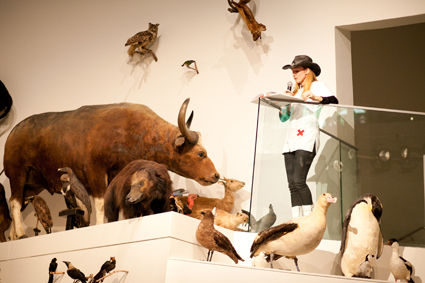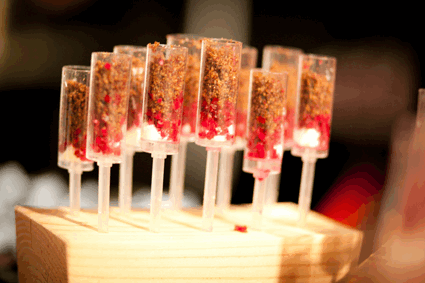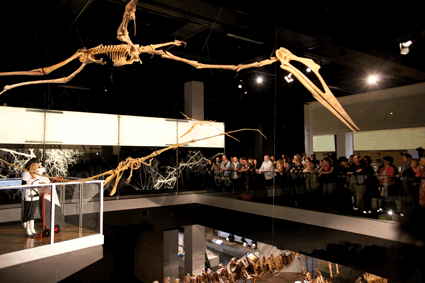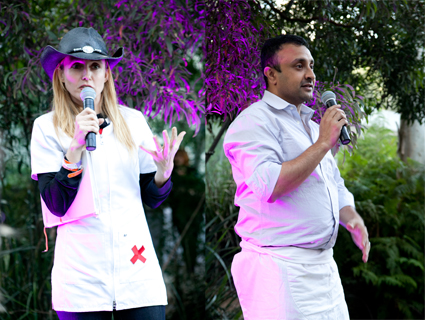edible, sensual, sustainable,
urszula dawkins: natalie jeremijenko & mihir desai, wilderness adventures for the palate

Natalie Jeremijenko, Wilderness Adventures for the Palate, Melbourne Museum
photo Giorgia Maselli
Natalie Jeremijenko, Wilderness Adventures for the Palate, Melbourne Museum
AROUND MID-WAY THROUGH WILDERNESS ADVENTURES FOR THE PALATE, THE COCKTAIL PARTY GUESTS ARE SHEPHERDED DOWN A SWEEPING STAIRCASE INTO THE MELBOURNE MUSEUM’SWILD: AMAZING ANIMALS IN A CHANGING WORLD EXHIBITION, WHERE WE AWAIT THE THIRD OF FOUR DELICIOUS AND CURIOUS EDIBLE/DRINKABLE ARTWORKS. LINING THE BRIGHT, WHITE WALLS OF THE BUNKER-LIKE CHAMBER ARE EVERY KIND OF TAXIDERMIED ANIMAL—FROM MINUSCULE FINCHES TO BABY RHINOCERI, CURLY-TAILED OPOSSUMS, FERRETS, JUMPING RATS, BEAR CUBS AND BIG CATS—ARRAYED IN AN UNFAMILIAR JUMBLE THAT COMPLETELY OVERTURNS TAXONOMICAL CONVENTION.
It’s a fittingly ‘re-imagined’ environment in which to experience the ambrosial delights of the second in Natalie Jeremijenko and Mihir Desai’s Cross(X)Species Adventure Club events: a travelling cocktail party through the halls of the museum exploring the economic, material and gastronomic interdependency between “humans and non-humans.” With its companion event, a five-course degustation dinner at Arc One gallery, the Cross(X)Species Adventure Club is designed to enlist tongues and tastebuds in an “art experience” that is by turns conceptual, performative, aesthetic and sensual.
The Cross(X)Species Adventure Club is one of a cornucopia of “prescriptions” developed by New York University’s Environmental Health Clinic, headed by prodigious scientist/engineer/artist Jeremijenko. Instead of pharmaceuticals, the Environmental Health Clinic prescribes a range of environmental actions and artistic interventions that trigger new thinking or explore unusual technological innovations.

Wilderness Adventures for the Palate, Melbourne Museum
photos Giorgia Maselli
Wilderness Adventures for the Palate, Melbourne Museum
The Museum’s Mind and Body Gallery, where the Wilderness Adventures begin, is all warm wood tones and soft glowing lights, echoing the mood of our first cocktail—a dark blood-coloured “Transfusion” of beet juice, vodka-infused shiraz and brandy. It’s tingly, slightly sweet and tastes distinctly of earth. Jeremijenko appears on a platform jutting out over the central atrium.
In black cowboy hat, white short-sleeved lab smock, black leggings and white boots, she explains the quality of the Victorian-Pyrenees-grown shiraz grapes, fermented to hold their subtle soil taste, describing the alcohol itself as “an amazing collaborator” with its living bacteria and yeast, and its ability to distil the most subtle of flavours. The vibe is not quite party and not quite performance—indeed when I speak with Jeremijenko about her work, she is adamant that she is not a performer.
Soon, a second cocktail—“Soiled Goods”—is served in a syringe-like tube and plunger: it’s strangely gritty, a sort of fetishistic tapenade which the curious audience self-dispenses into what Jeremijenko calls “our landscape-transforming mouths, and the instrument, our tongues.”
Jeremijenko’s collaborator for the Cross(X)Species Adventure Club is New York-based chef Mihir Desai. Prior to their being brought to Australia by environment/sustainability-focused arts producer Carbon Arts, the two have held their eco-inspired supper club in New York and Boston galleries, using ingredients ranging from edible flowers to snails. At the cocktail party, the medium of their collaboratively developed menu is in one sense the message, with its presentation of new, sustainable food options. At the same time, within the context of the event itself, the tastes become a kind of sensory shorthand, themselves summarising the detailed stories Jeremijenko tells about ingredients, supply chains and the specific environmental consequences of making alternative food choices.
When I speak with her prior to the events, Jeremijenko suggests that urban agriculture is “the space race of the 21st century.…it’s a complex systems design issue of how to produce food in an urban context and how to reintegrate vegetation back into the hard surfaces and the excessive structures that we’ve created,” she says. With the verbal knack of a high-tech entrepreneur, she outlines concepts such as “ag-bags”—another of the Environmental Health Clinic’s “prescriptions.” Made of non-degrading Tyvek slung across apartment building balconies and facades and linked by rain-guides, ag-bags are, she says, a kind of “luxury accommodation for snails” that “create arable territory out of thin air.”

Natalie Jeremijenko, Wilderness Adventures for the Palate, Melbourne Museum
photos Giorgia Maselli
Natalie Jeremijenko, Wilderness Adventures for the Palate, Melbourne Museum
Which brings us back to the Evolution Gallery and that third cocktail. Amid the bevy of still and video cameras (at times it feels like an over-paparazzied reception), waiters weave about with trays of long test tubes filled with a frothy white mix called “MaMa’s milk”—described by Jeremijenko as a tribute to the DaDa movement. The key ingredients are water-buffalo milk, milk thistle extract and snail foam.
Jeremijenko explains that water-buffalo milk is high in protein and fats and very creamy, and that if there were a demand for it, there would also be a demand for wetland. Milk thistle extract is capable of transforming cancerous lung cells to normal cells, she explains. And in case we’re in any doubt, snail milk, or foam, has high-value anti-wrinkle properties. The audience sucks at the test tubes, imbibing the creamy, slightly citrusy concoction and reflecting on the non-human ‘collaborators’ that have contributed to the treat.
The Cross(X)Species Adventure Club, says Jeremijenko, brings attention to alternative foods rather than competing with “the people growing vegetables and tomatoes and basil…We have a repertoire – a whole set of descriptions of edible flowers and berries and what I would call high-commercial-value, high-nutrition-value, highly perishable, non-distributable goods.
“When you pick a black pansy—the blackest flower ever bred—like many edible flowers, the delicate volatiles disappear within a few minutes of picking it. So how do you use these very perishable goods? There are a whole lot of methods: recipes for flash-infusing black pansies into vodka, right? So you can capture these ephemeral tastes that are very different from the kinds of foods that we’ve designed for storage in warehouses and on supermarket shelves and distributing through diesel trucks and shipping containers…”

Natalie Jeremijenko & Mihir Desai, Wilderness Adventures for the Palate, Melbourne Museum
photos Giorgia Maselli
Natalie Jeremijenko & Mihir Desai, Wilderness Adventures for the Palate, Melbourne Museum
Jeremijenko describes the “goose dinner” she created with Desai and chef/artist Deborah Solomon in Amsterdam: “So the goose dinner…was not where we ate the goose but where we ate what geese eat, these beautiful foods. Mihir is particularly interested in molecular gastronomy, which really looks at how science can make the processes and transformations in the kitchen very explicit, and with that, intensified tastes; and we can use new techniques to revisit, to reimagine familiar foods.”
The final offering of Wilderness Adventures for the Palate is served beneath the swaying eucalypts of the outdoor Forest Gallery. “Wetkisses” is a delicate, violet “vegan marshmallow” created with West Winds gin, crème de violette, LV methylcellulose, lemon and lime and dusted in something called “bio-char.” Once again we ingest the intriguing mix of ingredients while Jeremijenko explains their relationship to the damaging chytrid fungus, frogs and carbon sequestration.
While Wilderness Adventures of the Palate feels more like an art opening than ‘art,’ Jeremijenko’s introductions reveal the cocktails as unique, conceptual pieces—works that require us to deploy senses rarely called upon for art experiences. There are significant ironies in Jeremijenko’s approach: cocktail parties and degustation dinners are luxury experiences, even as vehicles to inspire and propagate new discourse about sustainability. And she herself notes that on subjects deemed ‘scientific,’ such as global warming, no one is rushing to listen to the views of an artist.
But Natalie Jeremijenko’s work is about individuals, she says, aimed at reversing the once useful strategy of making environmental issues ‘global’ enough to be newsworthy: “You can’t by definition do anything about global warming or global biodiversity. So instead of it being about polar bears and melting ice somewhere else, it’s about the air quality in this room and the food that you’re ingesting and the very direct way in which the shared environmental commons actually affects your own health—so that shifts us away from this internal, atomised, very pharmaceutical, genetically predisposed view of health.
“Not many people say ‘Oh yummy, a hearty meal of edible flowers’—so it’s really an opportunity to create food that is delicious and nutritious to humans and non-humans alike.”
Wilderness Adventures for the Palate, part of the Cross(X)Species Adventure Club, artist Natalie Jeremijenko, molecular gastronomist Mihir Desai, presented by Carbon Arts; Melbourne Museum, Dec 1, 2011; www.environmentalhealthclinic.net/projects/xspecies; www.carbonarts.org
This article first appeared as part o RT’s online e-dition Jan 31, 2012
RealTime issue #107 Feb-March 2012 pg. 12-13






